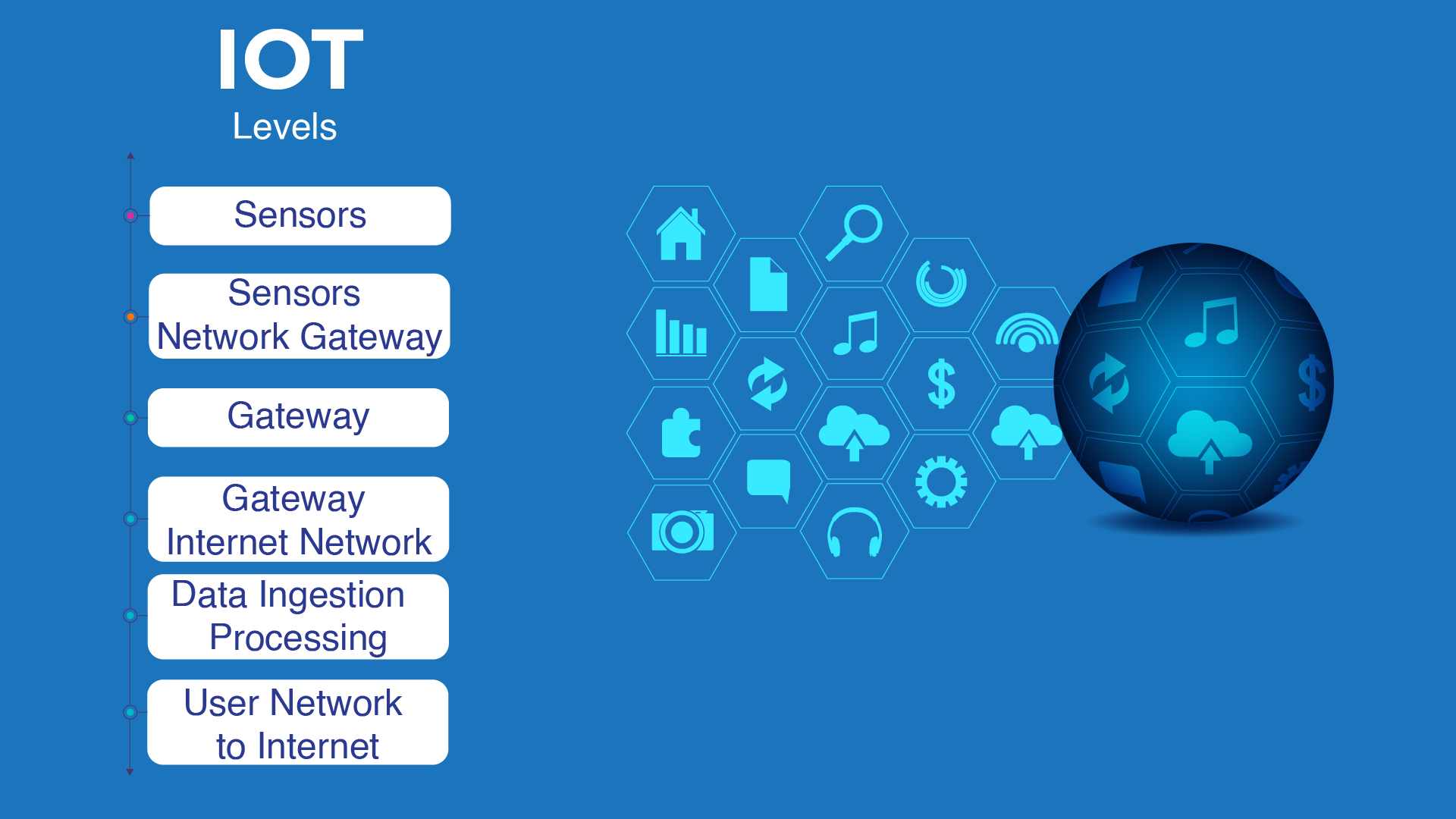Introduction
The Internet of Things (IoT) has silently become an integral part of daily lives, automating repetitive tasks and device communication. From fitness trackers that measure heart rates to industrial automation that predicts potential failure before happening, IoT simplifies everything. However, these small advancements together build a strong, well-structured network that streamlines the data transfer from one point to another. The process is not as simple as it looks—it follows a clear hierarchy that ensures real-time updates, efficiency, and informed decision-making. Behind every small interaction with IoT devices, the real warrior is hidden—the IoT hierarchy, which contains several levels. Understanding the IoT levels is helpful for anyone looking to uncover the power of IoT and know how these systems work.
Knowing the hierarchy and its levels provides valuable insights, whether used for home automation, business operations, or streamlining large-scale tasks. This blog will explain various levels of IoT, their roles, and their contribution to establishing a fully functional smart ecosystem.
What Are IoT Levels?
IoT is not only about a single system—it is a stack of cutting-edge interconnected layers that serve different purposes. Each layer is responsible for creating a system that collects, transmits, processes, and evaluates information to drive intelligent actions. IoT levels depend on each other, ensuring the structured flow of the data from raw data to mesmerising insights. The IoT developers follow this IoT hierarchy to design the system to ensure that the devices communicate securely and efficiently. It eliminates excessive clogging while securing the network by identifying potential vulnerabilities or bottlenecks.
Level 1: Sensors—The Foundation of IoT
The foundation and the first level of the IoT hierarchy are sensors—a small yet powerful unit that acts as the eyes and ears of the system. Sensors gather, transmit, and respond to real-world data obtained from functional blocks of IoT, such as pressure, humidity, and temperature. These devices collect physical raw data and transform it into digital signals—these discrete values can be read and displayed further. As the IoT applications expanded, protecting sensitive information became the top priority—leveraging sensors to ensure data security and process monitoring.
These systems can be used as simple motion detectors for system security and also as advanced biometric sensors for high-tech authentication processes. Sensors are available in a wide range of varieties designed to be used for every aspect of our lives.
- Temperature sensors for home automation systems
- Light Sensors for adjusting phone screen brightness
- Moisture Sensors for telling the health of soils
- Proximity Sensors for detecting nearby objects
- Accelerometers that trigger airbags in case of collisions
Level 2: Sensor Network Gateway—Bridging the Gap
After the data is collected, it requires a path to travel upward through the IoT hierarchy. This is where a crucial juncture of the IoT level—a sensor network gateway—comes into play. This bridge acts like an interconnected network of sensors that transform information from sensors to gateways using communication protocols. These networks use short-range and low-power communication protocols like Z-Wave, LoRaWAN, Zigbee, and Bluetooth to connect sensors. Think of it like a smart agriculture system integrated with the Internet of Things used for crop management. Where moisture sensors collect the soil details and send information to a central gateway for consolidation (filtering and organising relevant information).
Level 3 - Gateway
The transmitted data reaches a critical point of IoT architecture—the gateway, the middlelayer between the sensor network and the cloud. These IoT levels ensure that only relevant and necessary data reaches the internet, reducing latency and bandwidth consumption of time-sensitive operations. Gateways serve as security checkpoints that protect the networks from insecure devices and malicious actors aiming to exploit vulnerabilities.
For instance, in a smart real estate setting, the building might be equipped with thousands of sensors monitoring room occupancy and air quality. Instead of transmitting the raw data to the cloud, they communicate with gateways that filter the information. Additionally, they perform encryption for security and transmit only the valuable and necessary information for further processing.
Level 4: Gateway to the Internet Network: A Bridge to the Wider World
Now that the data has been collected and processed by the gateway and is secured by the gateway. The next step is to transmit the data to the internet for broader connectivity—this is where gateways to the internet network become crucial. This level of IoT hierarchy consists of several connectivity technologies that allow seamless communication between IoT devices and cloud-based platforms. Here are some of the connectivity technologies:
- WiFi
- Cellular Networks
- Ethernet
- Emerging LPWAN like LoRaWAN and NB-IoT
- Satellite Communication
Choose between them based on the availability of power, cost, deployment locations, and bandwidth requirements. Consider smart infrastructure management that might use traffic lights, air quality monitors, and surveillance cameras. The data they generate needs to be securely transmitted to central cloud servers—hence reliable and scalable connectivity is essential. This IoT level significantly eliminates this major bottleneck by establishing faster, more efficient, and more secure connectivity between gateways and cloud servers.
Level 5: Ingestion of data and Processing of Information—--Raw data to Meaningful Insights
Once the data is transmitted to cloud platforms or an on-premises data centre, it goes through the ingestion process. Here, the powerful computing system generates meaningful insights from raw sensor data using advanced storage, analysis, and processing systems. This comprehensive level of IoT not only streamlines the operational workflow but also saves costs, enhances efficiency, and boosts safety. Consider predictive maintenance in the manufacturing industry that has thousands of vibration sensors connected. These connected sensors send the data to cloud servers, where level 5 of the IoT hierarchy analyses patterns and predicts potential failures.
Level 6 - User Network to Internet
This last level in the physical design of IoT brings actionable insights back to users through applications and dashboards to use in the physical world. This IoT level ensures that decision-makers get real-time insights instantaneously from a mobile phone, on-premises cloud centers, and web interfaces. For example, a smart home system where users receive alert notifications when a data breach is detected. Same as in the automation industry, where supervisors keep track of factory performance through real-time dashboards, optimizing data-driven decision capabilities. Modern IoT platforms are rapidly evolving this level of automation to stay agile in the digitally competitive world of today.
Conclusion
From collecting raw data from sensors to providing actional insights to users, the IoT hierarchy represents the most significant advancement in the modern digital era. Understanding each interconnected IoT level with examples helps you to know the complexity behind simple smart devices. Each level contributes efficiently to creating integrated systems that connect the physical and digital worlds, ensuring automation, security, and communication. As the IoT continues to evolve, staying informed about the structural components of IoT is becoming essential to harnessing the full potential of IoT devices. Whether implementing IoT in business or developing a smart system, understanding how levels of IoT provide valuable contexts for the future of IoT transformation.
Moreover, incorporating creative technologies, embracing scalable designs, and prioritizing cost-effective technologies allow businesses to create relevant solutions. Such a solution can satisfy immediate requirements and create a pathway for long-term growth. However, to create a robust and effective IoT ecosystem, you must be familiar with core IoT concepts like IoT levels, fundamental building blocks, the conceptual framework of IoT, etc.
FAQs for IoT Levels
What are the different levels of IoT?
There are different levels of IoT but basically, this write-up will cover the six levels of Internet of Things. These six levels of IoT will assist you in understanding the working procedure of IoT smoothly.
What is the role of the Device Layer in IoT?
The device layer is the first layer of IoT that includes the sensing section such as sensors, actuators, and devices. With the assistance of these device layers, IoT devices are permitted to detect and collect the surrounding information and act accordingly.
How does the Connectivity Layer work in IoT?
The connectivity layer of the Internet of Things is responsible for their connectivity for the device's communications. The connectivity layer defines the concept of IoT device's communication with each other and with the internet.
What are the challenges in the Data Processing Layer of IoT?
The data processing layer of the Internet of Things has to face several challenges data volume, data security, data privacy, and data authenticity. Additionally, the Data Processing layer of IoT also has the challenge of the information exchange between software and then making use of them.
What security concerns are associated with IoT?
As IoT is a technology then it is pretty sure that IoT will bring some of the security issues such as weak authentication, data privacy, lack of standardization, & more.
Related Posts
What Are the Foremost Advantages & Disadvantages of IoT?
Internet of Things | IoT Design Methodology And Its Importance
Gain deeper insight into the CRM software and Internet of Things
IoT Data Visualization | Understand the Power of Connected IoT Devices



